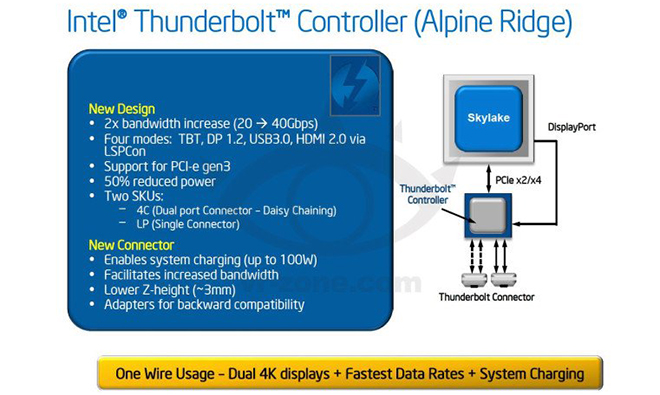In a purported presentation slide leaked to the Web on Monday, Intel outlines its next-generation Thunderbolt specification — "Alpine Ridge" — that will boast double the throughput of current Thunderbolt 2 interface, while bringing massive gains in power efficiency.
According to the supposedly leaked slide published by Chinese tech blog VR Zone, Intel is looking to significantly boost Thunderbolt's specs and compatibility with the next-gen product, while reducing power consumption for ultraportable computers.
As seen in the image above, Alpine Ridge will feature a new design capable of handling transfer rates up to 40 gigabits per second, double that of the current "Falcon Ridge" controller. Users will be able to pipe data through DisplayPort 1.2, USB 3.0 and HDMI 2.0. Also supported is generation three of the speedy PCIe bus.
On the power side, consumption will supposedly be decreased by 50 percent, while a new form factor connector brings 100 watts of charging power over a single cable. The next-generation plug is to be about 3mm thick and "facilitates increased bandwidth." Adapters will be available for backward compatibility.
The purported slide notes two connector types will be introduced in a dual port connector for daisy chaining and a single port version.
Assuming the slide is correct, Alpine Ridge will see release in 2015 alongside a new CPU dubbed "Skylake."
 AppleInsider Staff
AppleInsider Staff








 Christine McKee
Christine McKee
 Malcolm Owen
Malcolm Owen
 Marko Zivkovic
Marko Zivkovic

 Andrew Orr
Andrew Orr
 Andrew O'Hara
Andrew O'Hara
 William Gallagher
William Gallagher




-m.jpg)



107 Comments
We don't need 40 GBps, what we need is more Thunderbolt products, more affordable Thunderbolt products and Thunderbolt should have been reversible from day one.
Imagine if instead of this, Intel announced a new $5 Thunderbolt cables and dirt cheap licensing. How excited would you be then?
Right now Thunderbolt is like a drug that cures cancer but no one can afford and is generally unavailable. Part of good engineering of a spec is to make sure that it is practical. Intel has totally failed on that front.
We don't need 40 GBps, what we need is more Thunderbolt products, more affordable Thunderbolt products and Thunderbolt should have been reversible from day one.
Yet another armchair quarterback professing to be speaking for "us." Wrong. There's always room and need for more speed. It will be affordable to those who need it. And it doesn't need to be reversible like a charging cord, because, in many cases, it won't have to be connected/disconnected very often.
1) What can 100W reasonably power? 2) Is this 20Gib/s in each direction with an aggregate of 40GiB/s or 40Gib/s in each direction with an aggregate of 40Gib/s?